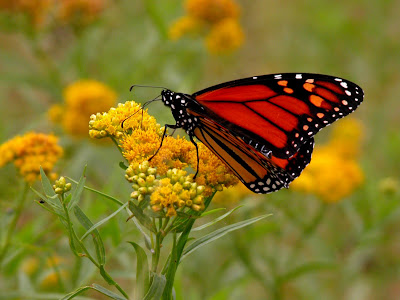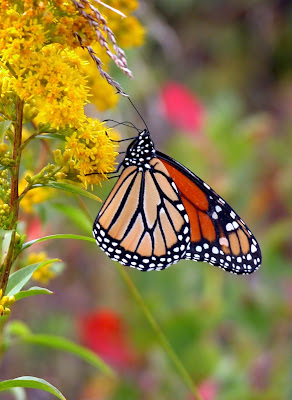Where are the Monarchs?
Have you noticed that there are fewer monarch butterflies than in years past? If so, you�re not alone. According to researchers, in the last 20 years the population of monarch butterflies in the eastern U.S. has declined by 90 percent. When Phyllis and I first started exploring Canaan Valley and Dolly Sods, we could count on joyfully chasing and photographing large numbers of monarchs in fields of goldenrod and aster. But not lately. It�s a big loss.
Where are the monarchs? According to experts there are three main reasons for the monarchs decline: 1) Loss of breeding habitat in the Midwest, 2) Loss of wintering-over habitat in Mexico, and 3) Severe weather.
The primary reason seems to be the decline in milkweed plants in the monarchs� breeding habitat in the Midwest. �The monarch cycles through 3-5 generations during the breeding season. Only the final generation migrates to Mexico. Monarch caterpillars feed exclusively on milkweed. Historically, the U.S. corn-belt has produced half of the monarchs that migrate to Mexico. However, milkweed habitat has been greatly reduced in the region due to� several factors (Elizabeth Howard).
Milkweed plants in the Midwest cornfields are in sharp decline due to the use of genetically modified corn and soy beans, which are resistant to herbicides. Thus farmers can freely apply herbicides, which kill milkweed plants but do not harm the crops. Moreover, rising corn prices spurred by increases in biofuels has pushed farmers to till up marginal ground containing milkweed and cultivate more crops.
Loss of wintering-over habitat is the second reason for the decline in monarch population. Migrating from their breeding ground, monarch butterflies travel up to 3,000 miles each fall to their wintering site in central Mexico. The winter sites are very concentrated. For example in winter 2013/2014, 78% of the population was concentrated in a single sanctuary (El Rosario). Being concentrated to a small area makes the monarchs� habitat more sensitive to deforestation, which is an ongoing problem, as well as disease, fire, and bad weather.
Indeed, the third reason for the decline in monarchs is severe weather. A drought in Texas or a cold snap in Mexico can contribute to monarch mortality. For example, in March of 2016 a late winter storm in Mexico destroyed 100 acres of forest habitat by toppling trees in high winds and killing them with cold temperatures. The same storm froze to death more than six million monarchs, about 7% of the total population.
It would be a shame to see the monarch, the official State butterfly of West Virginia, continue to decline. For more information and what you can do for the monarch butterfly visit http://www.monarchwatch.org/ .







Comments
Post a Comment